Introduction
The Corsair is a medium to long range thermal surveillance device targeted at the military and law enforcement. It packs a laser ranger finder (LRF), gyro stabilization, a ballistics calculator, navigation & tracking device, a streaming server and a weather station. All packed into one solid metal body with many of its sensors interconnected and working together.
Please note that we're reviewing a pre-production model in this review. IR&D is constantly adding new functionality through software updates. Also, in some videos when showing some of the Corsair's functionality I didn't calibrate the sensor, which I should have done. Lessons learned!
Quick specs
- Sensor resolution: 640 x 480
- Refresh rate: 60Hz
- Lens: 60mm F/1.0
- Laser Range Finder (1.5 km!)
- Navigation
- Target tracking
- Various internal and external weather sensor options
- Build-in ballistics calculations
- Video stabilization
- Video/Photo recording
- Wi-Fi, Bluetooth, 2.4 Ghz radio
Click here for the full specifications.
Aesthetics
Front view
The front-side of the Corsair spots a large 60mm lens, a DC connection, the Laser Range Finder, an IR laser pointer (we’ve been told it can be fitted with a visible red laser as well) and the microphone. Both the lens and IR laser pointer can be easily adjusted with the focus ring.
 Front view of the IR&D Corsair
Front view of the IR&D CorsairLeft view
Here we find two connections being well hidden by round screw caps. A micro-USB connection, which is used for data transfer (videos, images, maps) and to update the Corsair’s firmware. The other one being the Micro SD Card slot which accepts cards up to 32 GB. Please note that the 18650 batteries cannot be charged using the micro-USB connection.
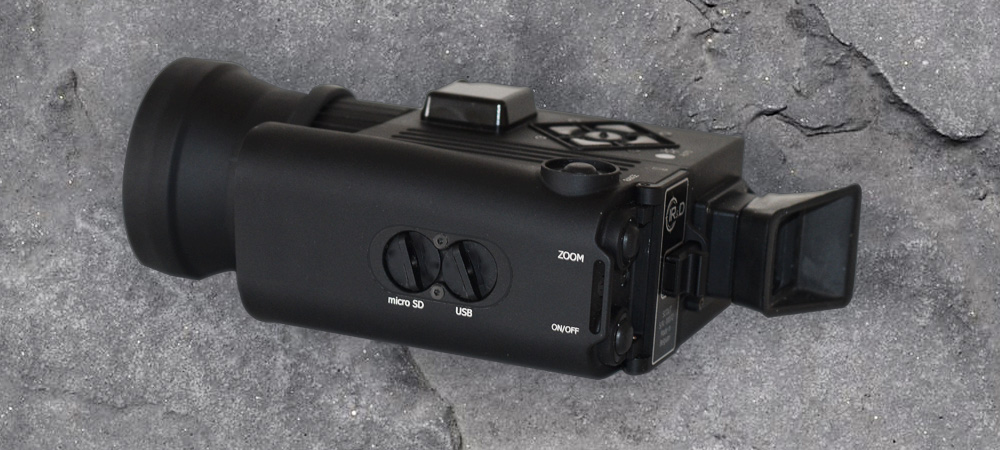 Left view of the IR&D Corsair
Left view of the IR&D CorsairBack view
On the back of the Corsair we have the viewfinder (featuring a crisp 800 x 600 OLED screen with proximity sensor), battery cover and the zoom- and power on/off button. The rubber eye-piece is shaped for right-eyed use by default but can be rotated 180 degrees to allow left-eyed operation. Also you’ll find two hinges for a neck lanyard.
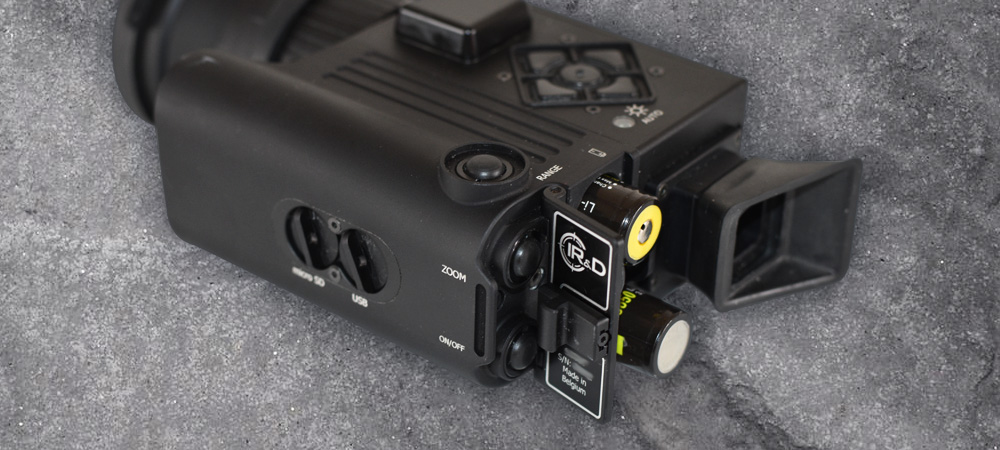 Back view of the IR&D Corsair
Back view of the IR&D CorsairRight view
Two buttons are available here; the image/video record button and a button which acts as a switch for the laser pointer and sensor calibration (FFC). Also there is a rail to add additional modules.
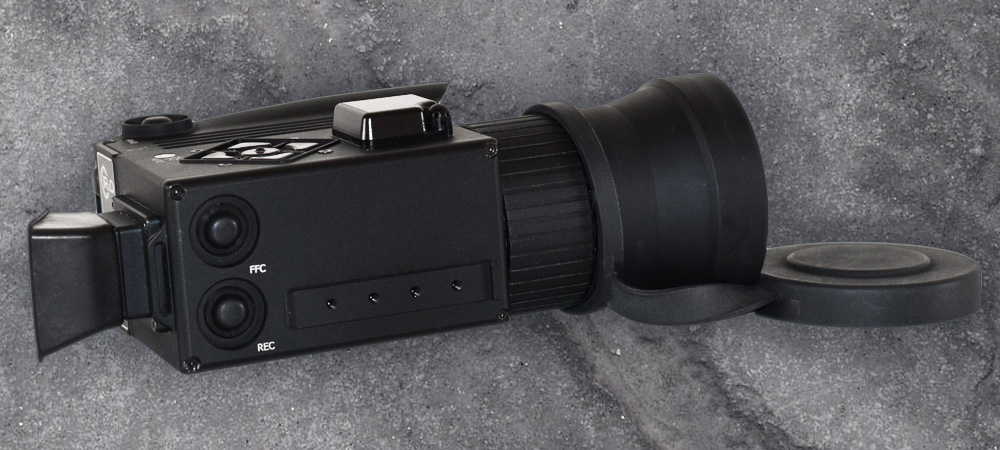 Right view of the IR&D Corsair
Right view of the IR&D CorsairTop view
The squared box sticking out is the GPS receiver, temperature-, pressure- and humidity sensor. Behind that we see the menu and navigational buttons. On the left you’ll find the Laser Range Finder button. Somewhere between the two there’s a light sensor as well. A detail we liked is that that all buttons of the Corsair are protected by a small edge around it.
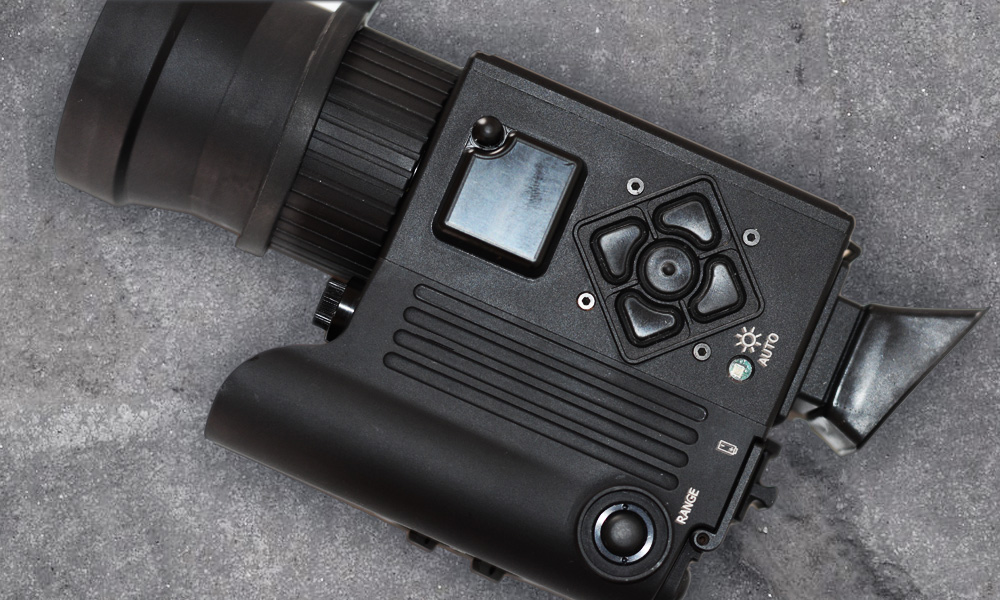 Top view of the IR&D Corsair
Top view of the IR&D CorsairBottom view
Not much to be found here besides a connection for your tripod and a diopter adjustment screw.
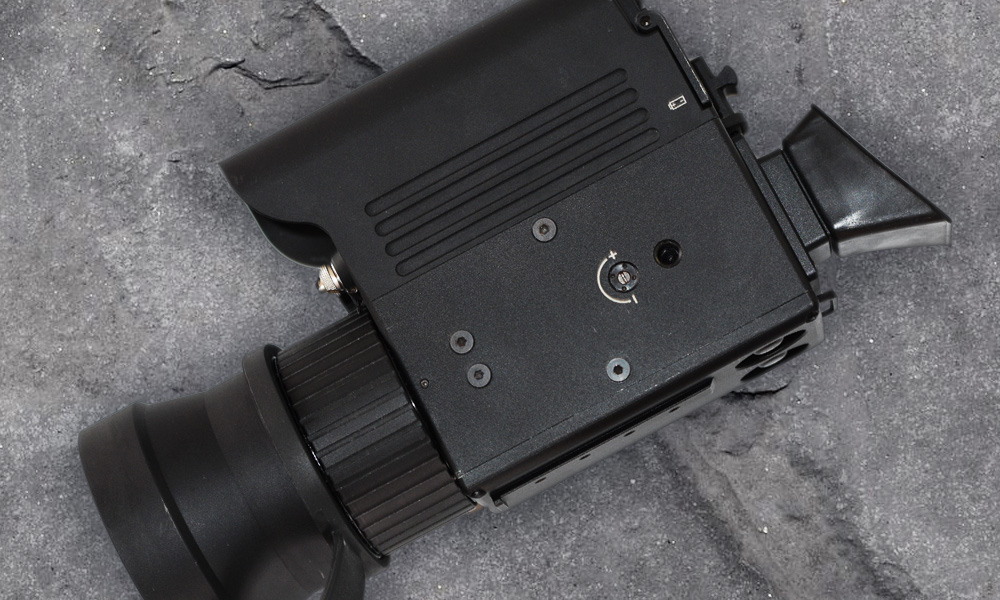 Bottom view of the IR&D Corsair
Bottom view of the IR&D CorsairInternal sensors & wireless interfaces
All features of the Corsair are heavily reliant on its sensors and it has a bunch of them packed inside such as a gyroscope, rest sensor, digital compass, roll-angle and elevation sensor. Wireless connections can be established over Wi-Fi, Wi-Fi direct, Bluetooth or the 2.4 GHz radio. Besides connecting your device to smartphones and computers for live video streaming they can connect to other IR&D devices such as an external weather station and a high-tech ‘wrist watch’.
Objective lens
The Corsair comes equipped with a 60mm F/1.0 lens made from germanium. The low f-ratio making sure it gathers as much thermal radiation as possible, offering detailed images and good contrast. You get a FOV of 10.4 x 7.8 degrees. Please note that custom lens configurations are possible as well to fit your mission's needs.
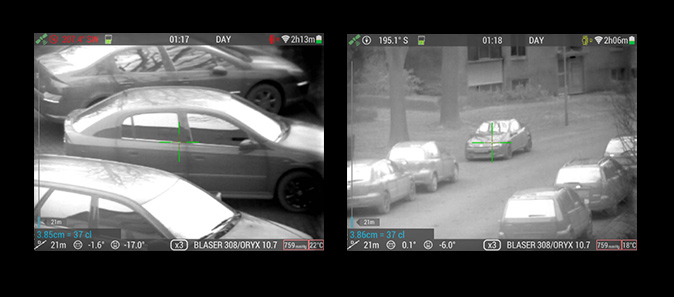
Thermal imaging sensor
Here we find an uncooled 640 x 480 microbolometer, based on a 17 µm production process, operating between the 7.5 and 13.5 µm waveband. The sensor can be either calibrated manually or automatically.
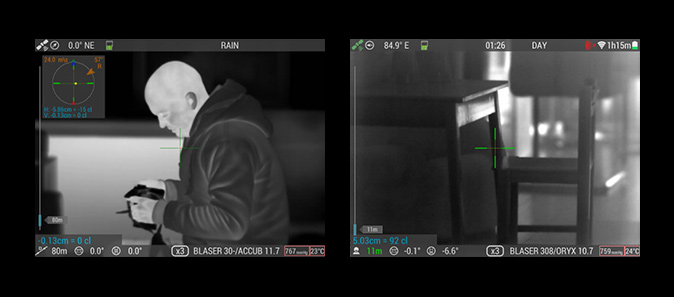
Ok great, but what it can actually do?
All of the above sounds nice on paper but I’m sure you’re here to see how this device performs, how it works and with some luck see the device in action. Don’t worry we’ve got you covered here. Let’s start by saying it’s not a device you pick up and run off with thinking you know all about it. Although navigating the menus is quite easy, the Corsair just has too many features to master within an hour or two. See it for yourself in the video below, giving you a run-down of the Corsair’s menus. To give you an indication, the video is over 8 minutes, and we ran through the menus fast!
Exploring Corsair’s features
In this section we will focus on specific features of the Corsair roughly keeping the navigation structure below in mind.
- Profiles
- Ballistics calculator
- Laser Range Finder
- Gyro stabilization
- Multimedia
- Navigation
- Connectivity
Profiles
The Corsair comes with 5 standard profiles (day, night, rain, fog and a user profile). You can choose to rename them as required and you can overwrite the selected profile with your updated settings such as gain and brightness. If you messed it up somewhere you can always revert to the factory settings for each profile.
Laser Range Finder
The Corsair is equipped with a highly accurate Laser Range Finder (LRF), measuring distances of over 1.5 kilometers.
A LRF calculates distances based on the speed of light. We know light travels at about 299,792 kilometers per second. Now, if we send a laser pulse (or series of pulses) to a target and measure the time between the sending and receiving its reflected light back at us we can calculate the distance it has traveled during that time.
The Corsair is accurate up to 1 meter which is without a doubt quite nice. It takes the elevation angle into account as well giving you the direct- and shooting distance measurements. You can set the number of pulses being sent in the range finder profile.
You’d choose a lower amount (min 1000) of pulses for shorter distances and a higher amount (max 5000) of pulses for long distances and better accuracy. You can choose a specific calculation algorithm to tell the device to measure based on first reflected light, last or the series with the strongest response.
Gyro stabilization
We haven’t seen this feature in other devices so far and the image stabilization does its job perfectly well. The screen might seem to go out of its boundaries a little but that’s needed to keep everything aligned and smooth. We suggest you turn this option off by default and enable it when you need to track a specific (moving) object or require a very still image for more detail. Of course you will enable this also when you’re at a moving object on an uneven terrain or out at sea.
Multimedia
The Corsair enables you to record videos (with audio) and take pictures; they are stored on the inserted Micro SD card. You can either record them with the click of a button or automatically using the Corsair’s motion detection.
All videos and pictures can be viewed with the built-in media player (they’re divided between media created by a button press and by motion detection).In the video setup menu you can enable/disable and set the microphone’s sensitivity. Another feature we found useful is ‘Synchronous recording’, with this enabled there will only be recorded when you’re looking through the viewfinder.
Videos and pictures can be transferred to your computer with the included Micro USB cable, of course you can read the Micro SD card directly too if needed.
Motion detector video recording
The Corsair can record video automatically when motion is detected. Its sensitivity, relative target size and interval can be set as well.
This feature is really useful when you’re observing a static region for movements but don’t have the time (or personnel) to alarm you when something happens. Just setup the Corsair and go do what you have to do, you will be informed about activity anyways, backed with video evidence.Checkout the video below and pay attention to the orange motion detector icon which flashes red whenever activity is happening.
Navigation
This devices comes with navigation and tracking and trust us… it’s awesome! Not only does it show your altitude, UTC time and of course your current location on the map, it’s firmly connected to the Laser Range Finder (LRF) as well.
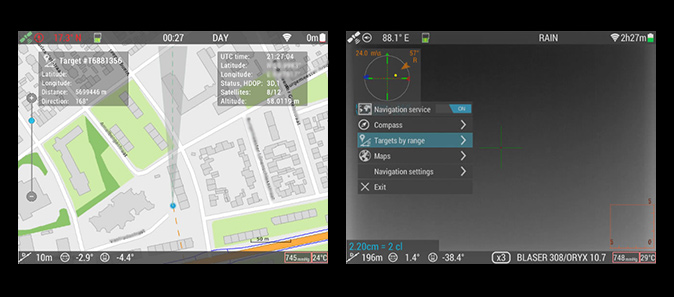
Imagine a scenario in where you’re doing initial scouting of an area and you’re spotting 3 objects of interest. Now, instead of keeping an IR laser pointed to that location, you can take a range measurement of the objects and their location is recorded automatically and stored in-memory and displayed on the map. For each target you’ll see their distance, coordinates and heading.
Maps can be downloaded freely and changed as necessary to include mission-related details. All targets are also saved on the SD card in small text files for post-mission data-processing.
Wireless connectivity
There are plenty of ways to connect with the Corsair using its Wi-Fi (and Wi-Fi direct), Bluetooth or 2.4 GHz radio interface.
Wi-Fi & Wi-Fi direct
Using the regular Wi-Fi connection you can connect to your local network and stream live video of the device to any device via the RTSP protocol. In our test we’ve used the freely available software ‘VLC media player’ to open the network stream. Just look up the IP address on your device, enter it in your video player (on a device which is connected to the same network) and start viewing. You can connect multiple devices to the same stream without any visible loss in quality.
Wi-Fi direct adds additional functionality by turning the Corsair into an access point. You can now connect your tablet or phone (both Apple and Android devices) to that access point, launch the IR&D app and besides viewing and recording the live stream you can control the device just by using your tablet or phone. It’s possible to zoom in/out and navigate the menus just the same way as using the physical buttons. A nice touch is that when motion detection is turned on you will be alerted on your phone/tablet as well.
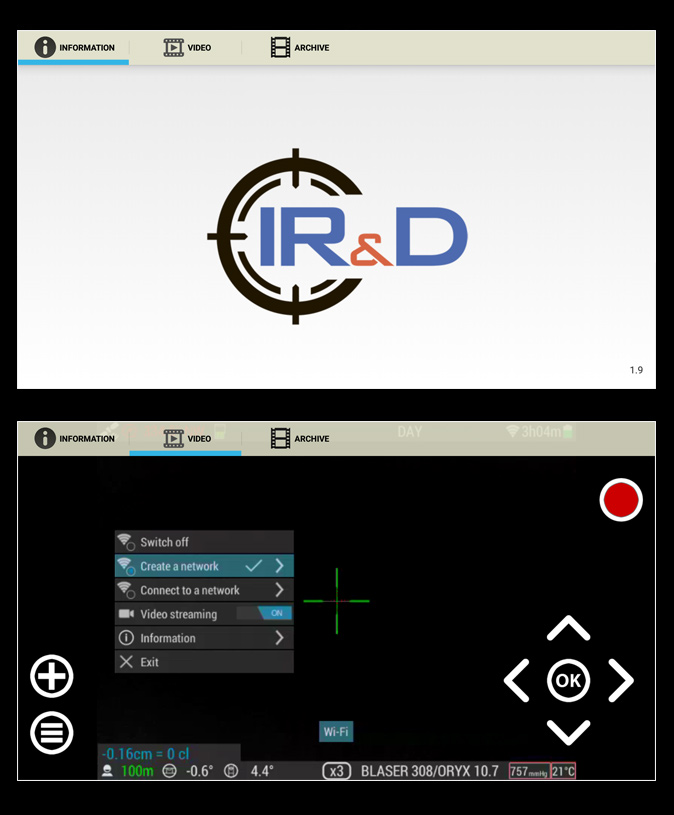 Recorded videos are stored on your phone/tablet and can be played back via the IR&D app. I couldn’t find the videos in my phone’s galleries though; they seem to be hidden from the regular file system.
Recorded videos are stored on your phone/tablet and can be played back via the IR&D app. I couldn’t find the videos in my phone’s galleries though; they seem to be hidden from the regular file system.Bluetooth
We haven’t been able to test this functionality and will update this article once we do.
2.4 GHz radio
The 2.4 Ghz radio interface connects other IR&D devices such as the remote control wristband (featured in our motion detection video) or a weather station (to get accurate wind-speed and direction) to further expand the Corsair’s features.